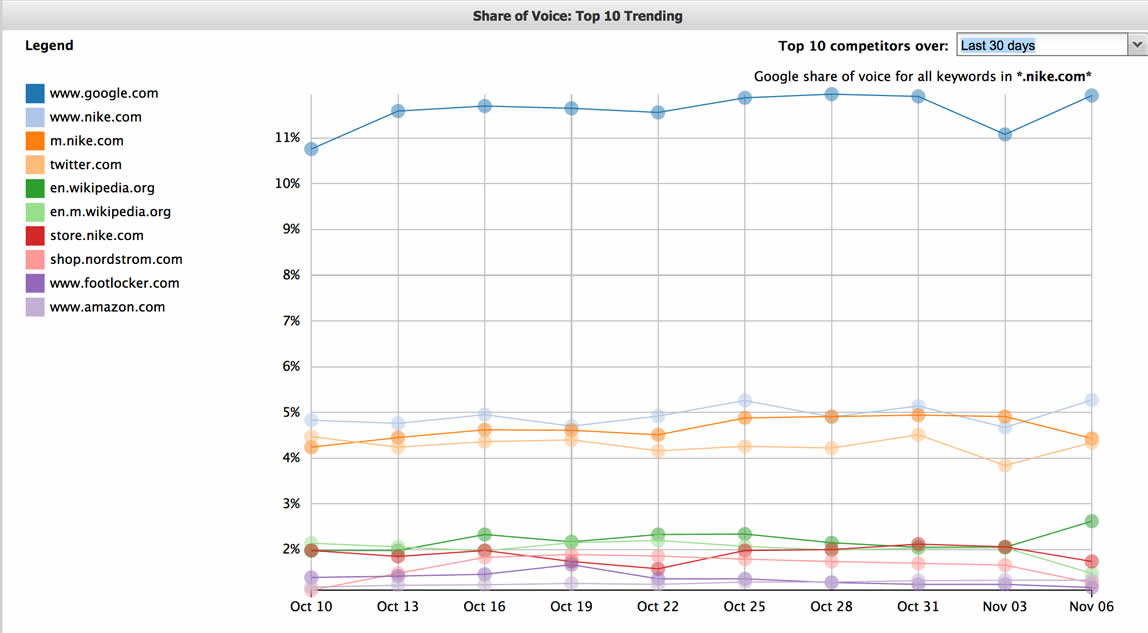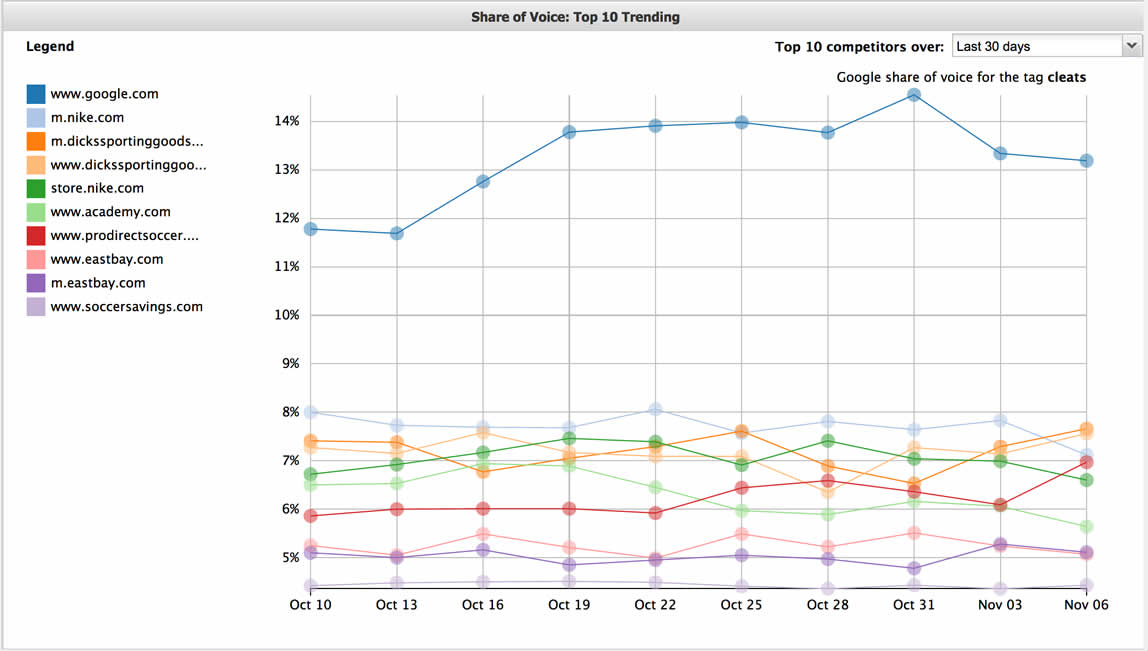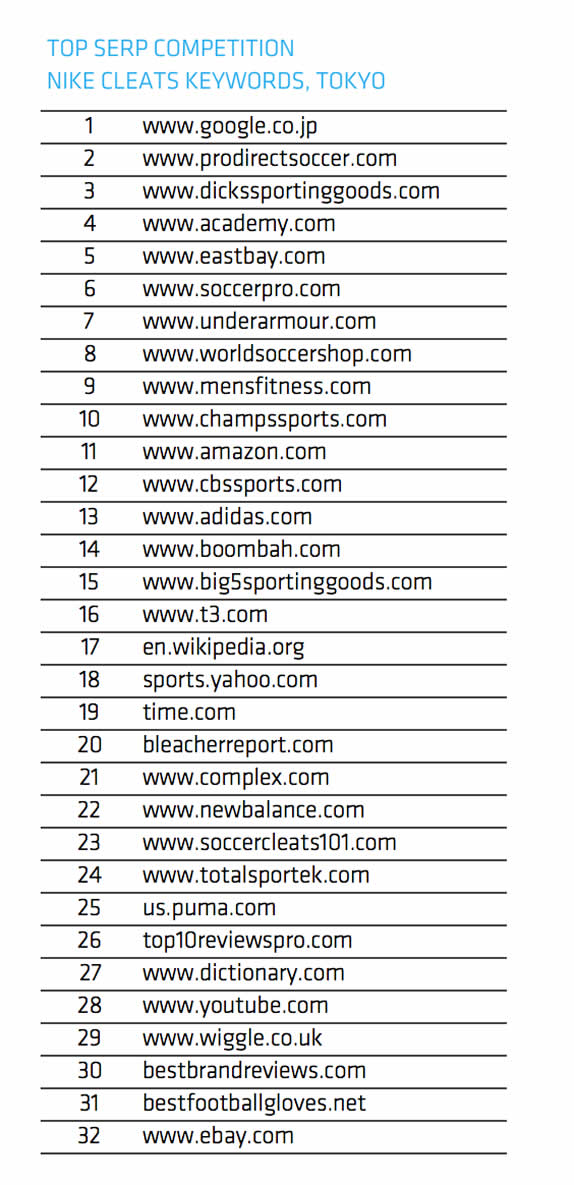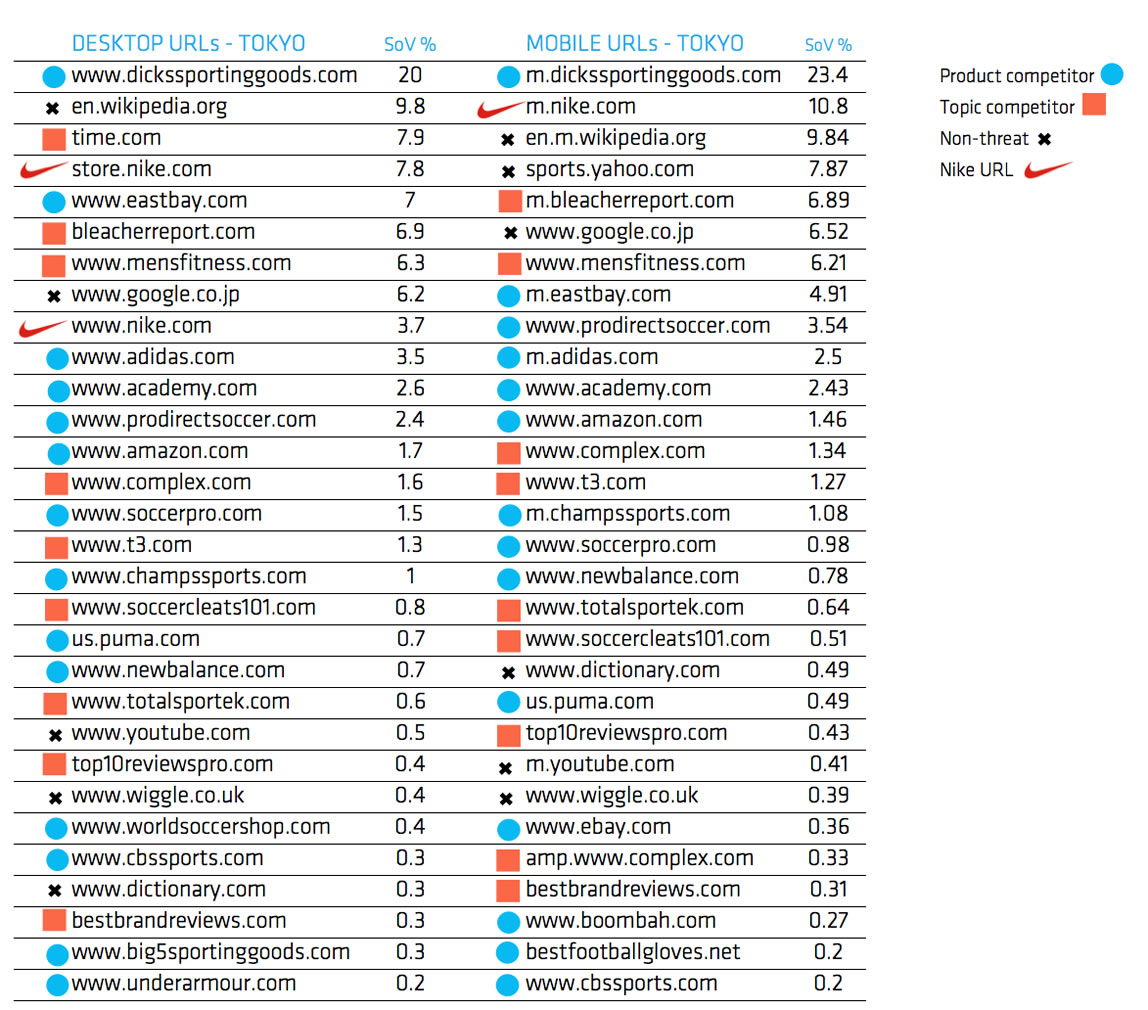Do you know who you’re really up against in the battle over SERP space?
Uncovering true threats in your organic competitive landscape can be difficult. Like trying to make your way through the mines of Moria, sometimes you need a little guidance.
At STAT, we like to think of segmentation and share of voice as your Gandalf, lighting your path and helping you slay pesky bridge trolls that stand in your way.
If that sounds like the kind of adventure you’re into, we’ll show you how to use segmentation and share of voice to track down the folks jockeying for position on your precious SERP space.
Step 1: Segment your keywords every way ‘til Sunday
Using Nike as our example site, we’ve decided to set our sights on product competitors.
When we look at the share of voice for our full 27,380 keyword set (1,369 website-inspired keywords x 10 locations across the globe x 2 devices), we don’t see a particularly insightful list on the Top 10 Trending graph for what we’re after.
Top-level share of voice:
These sites are winning share of voice for our keyword set over the past 30 days.
To start with, SERP giants like Google, Twitter, and Wikipedia typically hog the competitive landscape and can be complicated to compete with. For example, even if your Twitter game is strong enough to get your account on the SERPs, any clicks will still go to Twitter — so we tend to handle these sites differently.
And, given the scope of products that Nike sells, surely there are more sporting goods-related competitors than just Foot Locker to worry about. We’re also pretty certain that department stores like Nordstrom aren’t the go-to for things like cleats and compression socks, which are part of our keyword list — so who’s stealing that SERP space away from Nike?
The site view is a great high-level snapshot of your competitive landscape and an indication of how well your website is performing for all of your keywords, but it can’t draw your attention to specific areas that need improvement. This is why segmenting your keywords — by brand, search intent, SERP features, etc — is essential for success.
Since we want to cultivate a list of honest-to-goodness product competitors and come up with an actionable SEO game-plan, we’ve got to pull out the Ginsu knives and slice and dice our keywords.
Divvy up into product type
After grouping our keywords into every relevant product type — from accessories to workout clothes — we turn our focus to cleat-related keywords, and hop back to the Top 10 Trending graph to see who competes for that segment.
A whole new world!
Segmenting cleat-related queries from the rest of the keyword set shakes out a new group of competitors.
As it happens, Google also holds the top spot in this keyword segment thanks to universal results, but now Twitter, Wikipedia, and Foot Locker aren’t anywhere to be seen; DICK’S Sporting Goods, Academy, and Pro:Direct Soccer have replaced them as top competitors.
To further highlight the necessity of breaking keywords out into different segments, let’s take a quick peek at another product. In our “golf” keyword segment, the competition is very different — not only do we see golf-specific competitors there (surprise!), but it only shares four SERP competitors with our cleats segment.
The competitive landscape looks different
In addition to Nike, only four URLs are competing for both keyword segments.
While we’ve managed to surface some new competitors already, we’re still too high-level. This segment contains cleats keywords for all 10 cities that we’re tracking, and when locations are as unique as the people searching in them, they create equally unique competitive landscapes.
In order to get even more specific, we need to…
Add in location, location, location
If you’ve got brick and mortar stores across the globe like Nike does, tracking at the city or zip code level often reveals surprising local competition. So grab your passport, because we’re heading to Tokyo!
Location makes a difference!
Your competition will vary across markets.
For cleats keywords in Tokyo, Eastbay has joined the top 10 party, while Pro:Direct Soccer has called it a night. And speaking of surprises, DICK’S Sporting Goods is leading the way in share of voice for this English keyword set, knocking even Google off the top spot.
It’s interesting to see this North American company doing so well when they don’t have a brick-and-mortal presence in Tokyo. (We even triple-checked this SERP data with external proxies and real Google searches from STAT friends in Tokyo.)
Now that we’ve segmented by product and location, we’re finally getting somewhere with our keywords list — only one more piece of the segmentation puzzle to go.
Factor in device type
Since the way people search is different when they’re on mobile phones and desktop computers, device type will be our final layer of segmentation for these keywords.
This leaves us with two groups of keywords to focus our competitive analysis on:
- Cleats in Tokyo on desktop
- Cleats in Tokyo on mobile
And now we get to move on to the analysis.
Step 2: Export and analyse your SoV
Here's Nike's true cleat competition
Pulling the top competitors and getting rid of the non-threats, we end with this list.
For both of your keyword segments (cleats in Tokyo on desktop and cleats in Tokyo on mobile), head back to the Competitive Landscape tab, right-click on the Current Leaders board, and export all of that sweet, sweet share of voice data. It’ll give you 30 top competitor URLs to work with.
Consolidate the two lists by removing duplicate sites and combining brand URLs (ie. m.dickssportinggoods.com and dicksportinggoods.com is one competitor), and don’t forget to take yourself out of the equation.
When it comes to English cleats-related keywords in Tokyo, Nike competes for desktop and mobile SERP space with a grand total of 32 different brands.
Boom!
Step 3: Get your website research on for actionable insight
Next, hop onto the World Wide Web to see exactly what your top competitors are all about — are they business competitors or merely search competitors? After our investigation into Nike’s 32 SERP-adversaries, we:
- Eliminated six as threats. These are non-product competitors with a small share of voice or SERP giants like Google.
- Identified nine topic competitors. These sites write about cleats (reviews or general sports news) but don’t sell them, taking SERP space away from Nike.
- Zeroed in on 17 product competitors. All of these bad boys sell cleats.
Identify each type of competitor
Here we uncover product and topic competitors, as well as identify non-threats.
From this analysis, we discovered that Nike’s top two product (and SERP!) competitors are DICK’S Sporting Goods and Eastbay.
DICK’S is owning these keyword segments, consistently appearing above Nike on the SERPs. They hold more than two times the share of voice on mobile and more than five times the share of voice on desktop that Nike does.
As for Eastbay, both their desktop and mobile sites are out-performing Nike’s desktop site, though Nike is holding their own on mobile.
This tells us that Nike needs to seriously research these websites to see how they can beef up content around cleats, particularly for their desktop site. They should also examine how their overall UX compares — do DICK’S and Eastbay have better site speed and navigation?
On to the top three topic competitors — Men’s Fitness, Time, and Bleacher Report — Nike should consider how reviews and sports news could be incorporated into their site, or perhaps explore opportunities like sponsored content or paid advertising with them. These search competitors don’t need to sell your product to steal potential business away from you.
Mic drop.
So, now that you know how to use segmentation and share of voice to zero in on the competition, hopefully you’re feeling adventurous enough to try it yourself!
For STAT clients, if you need help setting up your segments or understanding the Competitive Landscape tab, or just want some additional training, reach out to ClientSuccess@getSTAT.com and we’d be happy to help. Don’t use STAT? Say hello, request a demo, and take us for a seven-day spin.
Epic kitten battle featured image courtesy of MaverickFoo








